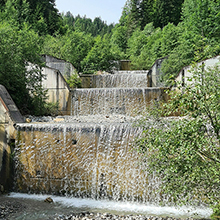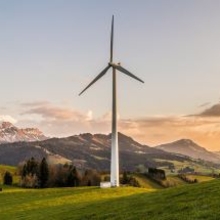Staff
Ivana Logar


About Me
Ivana leads a research group in Environmental Economics (EnvEco) at the Department of Environmental Social Sciences at Eawag.
She obtained her PhD degree in ecological economics (cum laude) in 2011 from the Institute of Environmental Science and Technology (ICTA) at the Autonomous University of Barcelona in Spain. Ivana joined Eawag as a postdoctoral researcher (2011-2013) at the Department of System Analysis, Integrated Assessment and Modelling (SIAM). She was also a visiting researcher (2011-2015) at the Department of Environmental Economics, Institute for Environmental Studies (IVM), Vrije Universiteit (VU) Amsterdam, in the Netherlands.
Research interests
- Environmental and natural resource economics
- Economic valuation of ecosystem services
- Methodological aspects of the stated preference valuation methods
- Choice experiments
- Economic analysis of changes in environmental quality (e.g. cost-benefit analysis)
- Economics of climate change
[[ element.title ]]
Projects
[[ element.title ]]
[[ element.title ]]
Publications
[[item.title]]
McFadden, I. R., Sendek, A., Brosse, M., Bach, P. M., Baity‐Jesi, M., Bolliger, J., … Narwani, A. (2023). Linking human impacts to community processes in terrestrial and freshwater ecosystems. Ecology Letters, 26(2), 203-218. doi:10.1111/ele.14153, Institutional Repository
Faragò, M., Damgaard, A., Logar, I., & Rygaard, M. (2022). Life cycle assessment and cost-benefit analysis of technologies in water resource recovery facilities: the case of sludge pyrolysis. Environmental Science and Technology, 56(24), 17988-17997. doi:10.1021/acs.est.2c06083, Institutional Repository
Moor, H., Gossner, M. M., Graham, C., Hobi, M. L., Logar, I., Narwani, A., … Altermatt, F. (2022). Besserer Biodiversitätsschutz in Blau-Grünen Ökosystemen. Des écosystèmes bleus-verts pour mieux protéger la biodiversité. Nature et Paysage. Natur und Landschaft: Inside (1), 25-29. , Institutional Repository
Moor, H., Gossner, M. M., Graham, C., Hobi, M. L., Logar, I., Matthews, B., … Altermatt, F. (2022). Blau-grüne Biodiversität ist ein wichtiger Teil des Waldes. Wald und Holz, 103(4), 30-33. , Institutional Repository
Pastor, A. V., Tzoraki, O., Bruno, D., Kaletová, T., Mendoza-Lera, C., Alamanos, A., … Jorda-Capdevila, D. (2022). Rethinking ecosystem service indicators for their application to intermittent rivers. Ecological Indicators, 137, 108693 (17 pp.). doi:10.1016/j.ecolind.2022.108693, Institutional Repository
Späti, K., Huber, R., Logar, I., & Finger, R. (2022). Data on the stated adoption decisions of Swiss farmers for variable rate nitrogen fertilization technologies. Data in Brief, 41, 107979 (8 pp.). doi:10.1016/j.dib.2022.107979, Institutional Repository
Späti, K., Huber, R., Logar, I., & Finger, R. (2022). Incentivizing the adoption of precision agricultural technologies in small‐scaled farming systems: a choice experiment approach. Journal of the Agricultural and Applied Economics Association, 1(3), 236-253. doi:10.1002/jaa2.22, Institutional Repository
Jorda-Capdevila, D., Iniesta-Arandia, I., Quintas-Soriano, C., Basdeki, A., Calleja, E. J., DeGirolamo, A. M., … Padło, T. (2021). Disentangling the complexity of socio-cultural values of temporary rivers. Ecosystems and People, 17(1), 235-247. doi:10.1080/26395916.2021.1912186, Institutional Repository
Kaletova, T., Rodriguez-Lozano, P., Berger, E., Filipa Filipe, A., Logar, I., Alves, M. H., … Jorda-Capdevila, D. (2021). Considering temporal flow variability of non-perennial rivers in assessing ecosystem service provision. Ecosystem Services, 52, 101368 (6 pp.). doi:10.1016/j.ecoser.2021.101368, Institutional Repository
Moor, H., Gossner, M. M., Graham, C., Hobi, M. L., Holderegger, R., Reber, U., … Shipley, R. (2021). Biodiversitätsschutz dank Ökosystem-übergreifendem Denken. Forschungsinitiative Blau-Grüne Biodiversität (BGB). Aqua & Gas, 101(12), 44-49. , Institutional Repository
Logar, I., Brouwer, R., & Campbell, D. (2020). Does attribute order influence attribute-information processing in discrete choice experiments?. Resource and Energy Economics, 60, 101164 (21 pp.). doi:10.1016/j.reseneeco.2020.101164, Institutional Repository
Glatt, M., Brouwer, R., & Logar, I. (2019). Combining risk attitudes in a lottery game and flood risk protection decisions in a discrete choice experiment. Environmental and Resource Economics, 74(4), 1533-1562. doi:10.1007/s10640-019-00379-y, Institutional Repository
Logar, I., Brouwer, R., & Paillex, A. (2019). Do the societal benefits of river restoration outweigh their costs? A cost-benefit analysis. Journal of Environmental Management, 232, 1075-1085. doi:10.1016/j.jenvman.2018.11.098, Institutional Repository
Mattmann, M., Logar, I., & Brouwer, R. (2019). Choice certainty, consistency, and monotonicity in discrete choice experiments. Journal of Environmental Economics and Policy, 8(2), 109-127. doi:10.1080/21606544.2018.1515118, Institutional Repository
Logar, I., & Brouwer, R. (2018). Substitution effects and spatial preference heterogeneity in single- and multiple-site choice experiments. Land Economics, 94(2), 302-322. doi:10.3368/le.94.2.302, Institutional Repository
Schuwirth, N., Honti, M., Logar, I., & Stamm, C. (2018). Multi-criteria decision analysis for integrated water quality assessment and management support. Water Research X, 1, 100010 (11 pp.). doi:10.1016/j.wroa.2018.100010, Institutional Repository
Brouwer, R., Logar, I., & Sheremet, O. (2017). Choice consistency and preference stability in test-retests of discrete choice experiment and open-ended willingness to pay elicitation formats. Environmental and Resource Economics, 68(3), 729-751. doi:10.1007/s10640-016-0045-z, Institutional Repository
Logar, I., & Brouwer, R. (2017). The effect of risk communication on choice behavior, welfare estimates and choice certainty. Water Resources and Economics, 18, 34-50. doi:10.1016/j.wre.2016.11.004, Institutional Repository
Mattmann, M. (2017). Testing choice theory using discrete choice experiments in Swiss energy policy (Doctoral dissertation). Vrije Universiteit Amsterdam, Amsterdam, 187 p. , Institutional Repository
Tilley, E., Logar, I., & Günther, I. (2017). The effect of giving respondents time to think in a choice experiment: a conditional cash transfer programme in South Africa. Environment and Development Economics, 22(2), 202-227. doi:10.1017/S1355770X16000280, Institutional Repository
Mattmann, M., Logar, I., & Brouwer, R. (2016). Hydropower externalities: a meta-analysis. Energy Economics, 57, 66-77. doi:10.1016/j.eneco.2016.04.016, Institutional Repository
Mattmann, M., Logar, I., & Brouwer, R. (2016). Wind power externalities: a meta-analysis. Ecological Economics, 127, 23-36. doi:10.1016/j.ecolecon.2016.04.005, Institutional Repository
van Dijk, D., Siber, R., Brouwer, R., Logar, I., & Sanadgol, D. (2016). Valuing water resources in Switzerland using a hedonic price model. Water Resources Research, 52(5), 3510-3526. doi:10.1002/2015WR017534, Institutional Repository
Brouwer, R., Kuik, O., Sheremet, O., Jiang, Y., Brands, D., Gerdes, H., … González del Tánago, M. (2015). Cost-effective restoration measures that promote wider ecosystem and societal benefits. REstoring rivers FOR effective catchment Management. sine loco: sine nomine. , Institutional Repository
Gsottbauer, E., Logar, I., & van den Bergh, J. (2015). Rejoinder to Kallis et al.'s response to our criticism. Ecological Economics, 118, 285-286. doi:10.1016/j.ecolecon.2015.07.030, Institutional Repository
Gsottbauer, E., Logar, I., & van den Bergh, J. (2015). Towards a fair, constructive and consistent criticism of all valuation languages: comment on Kallis et al. (2013). Ecological Economics, 112, 164-169. doi:10.1016/j.ecolecon.2014.12.014, Institutional Repository
Logar, I., Brouwer, R., Maurer, M., & Ort, C. (2015). Wert der Spurenstoffelimination. Eine ökonomische Analyse zum Ausbau Schweizer Abwasserreinigungsanlagen. Aqua & Gas, 95(2), 42-48. , Institutional Repository
Logar, I. (2015). [Review of the book Determining the economic value of water: concepts and methods (2nd edition), by R.A. Young & J.B. Loomis]. Water Resources and Economics, 11, 47-49. doi:10.1016/j.wre.2015.04.002, Institutional Repository
Meyer, V., Schwarze, R., Becker, N., Markantonis, V., van den Bergh, J. C. J. M., Bouwer, L. M., … Viavattene, C. (2015). Assessing the costs of natural hazards - state of the art and the way forward. In P. Quevauviller (Ed.), Hydrometeorological hazards. Interfacing science and policy (pp. 255-290). doi:10.1002/9781118629567.ch4a, Institutional Repository
Kreibich, H., van den Bergh, J. C. J. M., Bouwer, L. M., Bubeck, P., Ciavola, P., Green, C., … Thieken, A. H. (2014). Costing natural hazards. Nature Climate Change, 4(5), 303-306. doi:10.1038/nclimate2182, Institutional Repository
Logar, I., Brouwer, R., Maurer, M., & Ort, C. (2014). Cost-benefit analysis of the Swiss national policy on reducing micropollutants in treated wastewater. Environmental Science and Technology, 48(21), 12500-12508. doi:10.1021/es502338j, Institutional Repository
Logar, I., & van den Bergh, J. C. J. M. (2014). Economic valuation of preventing beach erosion: comparing existing and non-existing beach markets with stated and revealed preferences. Journal of Environmental Economics and Policy, 3(1), 46-66. doi:10.1080/21606544.2013.863742, Institutional Repository
Mihalič, T., & Logar, I. (2014). Teoretični in aplikativni pristopi za spremljanje okoljske uspešnosti. In T. Mihalič (Ed.), Oblikovanje modela merjenja uspešnosti poslovanja hotelskih podjetij (pp. 36-67). Retrieved from http://www.ef.uni-lj.si/content/static_slovene/zaloznistvo/publikacija.asp?id_pub=434, Institutional Repository
Logar, I., & van den Bergh, J. C. J. M. (2013). Methods to assess costs of drought damages and policies for drought mitigation and adaptation: review and recommendations. Water Resources Management, 27(6), 1707-1720. doi:10.1007/s11269-012-0119-9, Institutional Repository
Logar, I., & van den Bergh, J. C. J. M. (2013). The impact of peak oil on tourism in Spain: an input-output analysis of price, demand and economy-wide effects. Energy, 54, 155-166. doi:10.1016/j.energy.2013.01.072, Institutional Repository
Meyer, V., Becker, N., Markantonis, V., Schwarze, R., van den Bergh, J. C. J. M., Bouwer, L. M., … Viavattene, C. (2013). Review article: assessing the costs of natural hazards – state of the art and knowledge gaps. Natural Hazards and Earth System Sciences, 13(5), 1351-1373. doi:10.5194/nhess-13-1351-2013, Institutional Repository
Logar, I., & van den Bergh, J. C. J. M. (2012). Respondent uncertainty in contingent valuation of preventing beach erosion: an analysis with a polychotomous choice question. Journal of Environmental Management, 113, 184-193. doi:10.1016/j.jenvman.2012.08.012, Institutional Repository
[[item.title]]
[[ entry.title]]
[[ element.title ]]
[[ element.title ]]
Address
| E-Mail: | ivana.logar@cluttereawag.ch |
| Phone: | +41 58 765 5504 |
| Fax: | +41 58 765 5802 |
| Address: | Eawag
Überlandstrasse 133 8600 Dübendorf |
| Office: | FC E12 |
[[ element.title ]]
[[ element.title ]]
Expert on
sustainable water management,
Ecosystem services,
environmental economics




